Week 2 - Course Notes
Course: Learning how to learn by Dr. Barbara Oakley, Dr. Terrence Sejnowski Course claim: Learn more effectively and with less frustration
Chunks
Compact packages of information our mind can easily access. (connects with [[BASB - Learning about Express#Approach to work with intermediate packages IP to increase ROA|Intermediate packets]])
- Link pieces of information together to create a new meaning or use.
- A network of neurons that are used to firing together … to enable smoothly and more efficient usage of our brains.
- Need to connect and understand the context
- Chunks enable an efficient usage of our working memory
Octopus of attention reaching through 4 focus points of focussed brain
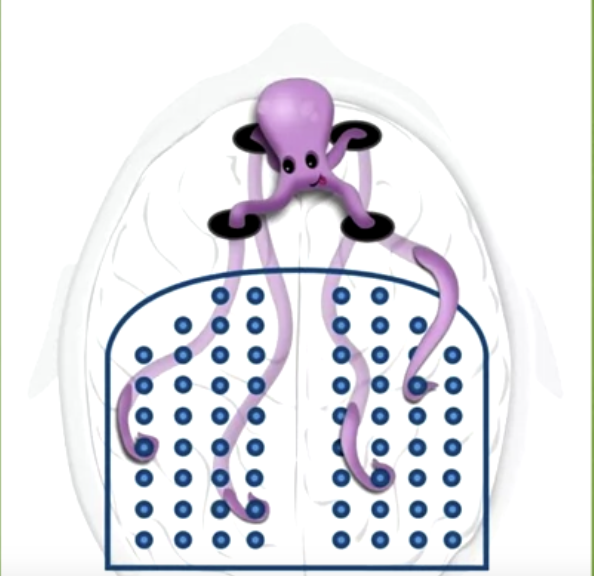
Different building blocks that form networks and are the foundation for storing chunks in our brain
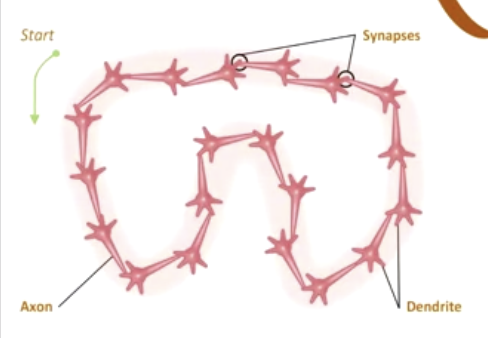
How to form a chunk
- Practice and repetition on building chunks
- Focussed mode is about building these connection via a focussed search.
- Stress reduces the ability to be in a focussed mode, and therewith to make these connections. (extends to being angry, stressed, afraid).
-
Get an initial overview on the pattern to master in order to acquire a skill.
- E.g. guitar playing of a song - patterns of how to hold the guitar, how does the song sound like, what are song elements, how to play certain sounds, who are counterparts,…
- start with mini-chunks and link them later to larger chunks (e.g. sports and small skills extensions).
- best chunks - the ones where you even don’t have to think about it anymore
-
Work with sample problems and worked out solutions. With a work-through example to address the already high cognitive load when learning something new (like listening to a song before trying to play it by yourself)
- figure out the main steps that were taken
- pay attention to what is going on around you
Some aspects applied to learning a language
- structured repetition and ^kuyvw6
- rote focus mode learning
- combined with diffuse mode of speaking freely with friends
Steps of forming a chunk
Focus full attention on the information to chunk
- focus (avoid interruptions)
- intention: to have all four focus points fully directed to the information
Understand the basic idea
- what is the main idea
- alternate between focussed and diffused mode
- one needs to understand it in order to form a useful chunk
- repeat and test your understanding by taking a test. This way you can see if you understood a topic.
Do it - Practice
Actually, when you can do it by yourself, then on got a real understanding of it.
Doing creates the underlying neural pattern that manifests the understanding. Practicing makes the chunk accessible from many different paths.
Gain Context
Context means to learn when to use e.g. a technique
Use chunks and link them to a wider context. (like Birkenbihl suggest to link it with already available knowledge).
Context is where bottom-up & top-down meet. Start with big picture and the then fill in the details.
Bottom up and top down learning connect with the context of what you learn.
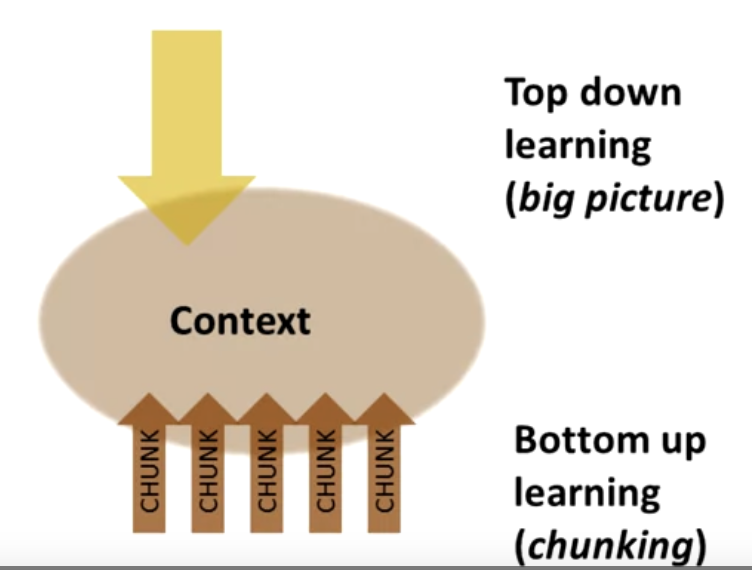
Top Down - Big Picture learning
- Learn when to use the chunk.
- Learn when not to use it
- see what you learn and where it fits in
- e.g. by glancing pictures and headlines of something to learn, listening, outlines, flow charts, concept maps
- build the baseline to understand how different chunks belong together
- repeat with connected junks and seemingly unrelated concepts.
Bottom up Learning
Bottom up learning. Learn how to use a chunk. Practice and repeat
Illusion of competence
Recall
Mental retrieval of the key ideas.
- re-reading a book is not productive
- check what you can recall from a reading
- try to remember the key ideas
- simply practice & recall enables a far more and deeper level of learning
- retrieval of information itself helps us to begin forming chunks
- only use deeper connection building (e.g. concept maps) once the initial chunks are embedded in the brain (like playing advanced chess without understanding the basics of it)
After chunking (for what one needs all the working memory), chunks can be used in one of the 4 slots in your working memory (instead of occupying all four) and form pointers to bigger underlying knowledge. A chunk does not occupy the full working memory.
Apply recall also when outside of your ordinary learning space. And also prepares e.g. for later taking a test in a different location.
Illusion of competence
The solution hast to be mine. Just glancing on a solution and thinking one understood/knows it is the illusion of competence in learning.
Information has first to be persistent in your memory (or extended memory using Second Brain?) to then master the material well enough and to think creatively with it.
For highlighting in text - look for the main idea before making any mark. One sentence of less per paragraph. Be aware that highlighting might lead to the assumption that you understood the topic. (Reflection for Progressive Summarization - here highlighting is a step in a chain of steps to distill knowledge. That is different from a plain highlighting mode in a textbook)
Words or notes on the margin of a reading, that synthesize key concepts are a very good idea.
To work agains the illusion of competence: Test yourself on the learning. And recalling allows to check whether one really grasp the idea.
Mini-testing
Help to uncover illusion of competence and detect fields where to further focus on understanding and learning.
- Do little self tests, where mistakes are cheap.
- Recall is a form of mini-testing
- another example are Anagrams - rearrangement of letters. E.g. Me, radium ace = Madam Curie
Value of making mistakes
Help correct thinking.
How to integrate a Flashcard Retrieval system
Retrieval practice. Retrieval is strengthening the links. It is the best way to learning. Boosts conceptual understanding.
Use flashcards to retrieve information over a number of days.
iDoRecall.com , but actually I can use this inside Obsidian.
- Re-learn to use spaced repetition in Obsidian
What motivates you?
Neuromodulators - carry information about value and importance of an information in the future.
Emotions play an important role. Emotions are intertwined with perceptions and attention and interact with learning and memory. The amygdala integrates emotions and cognition. Involved in processing memory and decision making. Keep the amygdala happy to be an effective learner.
Acetylcholine Neurons
- form connections, important for focussed learning
- leads to new long term memory
Dopamine Neurons
- Motivation is controlled by dopamine
- Controls reward learning - dopamine is released when we receive an unexpected reward
- affects learning and decision making
- also transmitted when projecting future rewards
- drugs increase dopamine but hijack free will
Serotonin
- affects social life
- linked to risk taking behavior - lower levels lead to higher risk taking
More on brainfacts.org
Value of a library of chunks
Assumption: This library of chunks is a synonym for a Second Brain.
More chunks also help to understand new concepts faster. Compound learning.
A chunk library accessed in diffuse thinking. Based on a chunk a whole idea can be accessed much faster and lead to higher levels of new ideas, where whole concepts can be combined
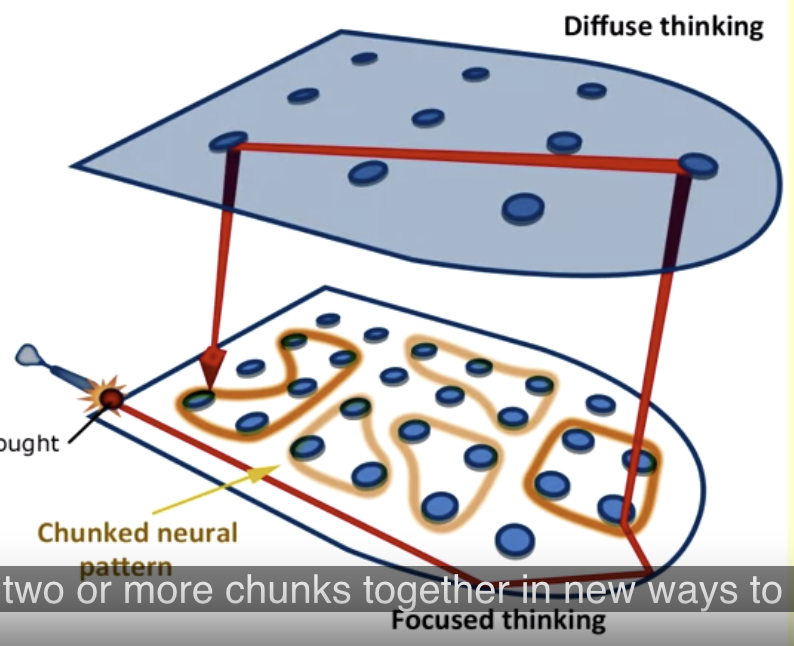
Two ways to figure out something - Sequential and Intuition based
Sequential and Holistic visualized
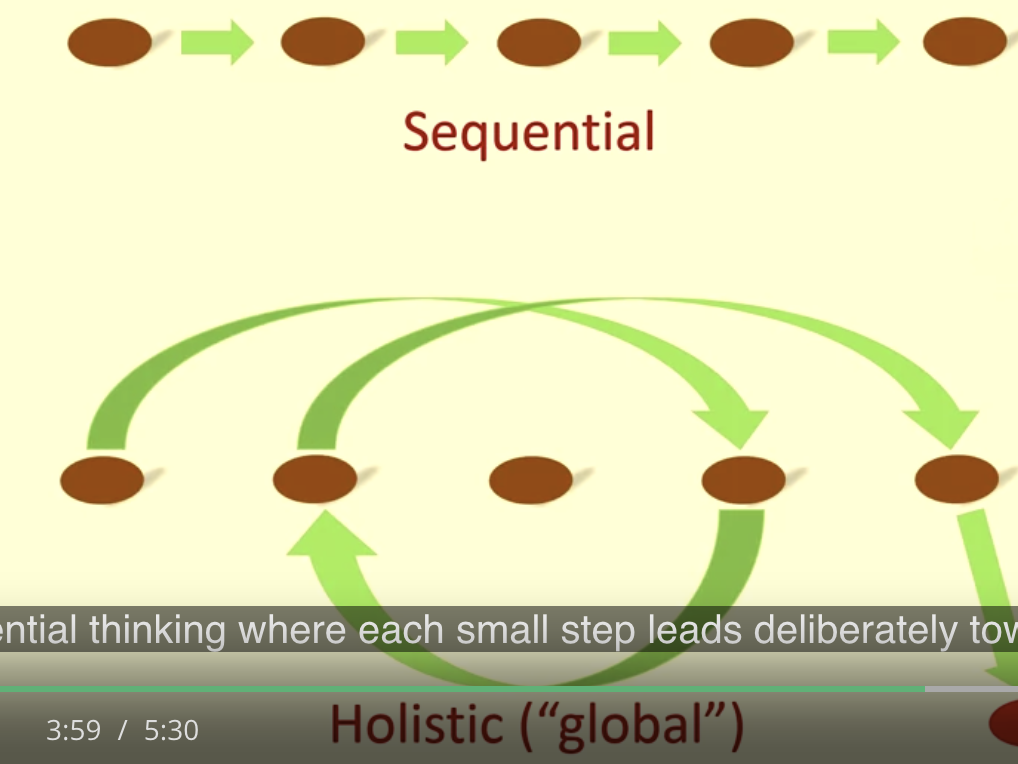
Sequential
Step by Step reasoning
Holistic - intuition based
More in diffused mode. To connect several focus mode made chunks. Verify discoveries via focussed mode validation
Compaction
Gradually build number of chunks in their mind. A chunk is compressing information much more compactly.
Transfer
Combine chunks with existing chunks in other domains/fields of expertise.
Creativity
Increasing the number of valuable chunks leads to higher creativity. Creativity through new ways to recombine things to create something new.
Law of Serendipity
Lady Luck favors the one who tries. It does get easier over time and with more and more knowledge chunks in the mental library. And it leads to new discoveries and connections.
Overlearning - choking - interleaving
Overlearning
Repeat again and again what you already mastered in a session. Can help with automaticity (e.g. public speaking, sports moves).
Don’t do so much of it during a single session.
Instead start focussing on the more difficult aspects. This is called deliberate practice.
Reflect on your mindset. Are you open to new perspectives and new discoveries or is the current understanding more fixed nature. One needs often to unlearn.
With fixed mindset one blocks a thought from reaching knowledge pattern areas in a another region of our brain.

Interleaving
Jump back and forth between different problems and situations that require different techniques or strategies. Interleaving helps with learning when to use a technique, concept.
Use interleaving once you understood the basic idea/concept.
Can be implemented e.g. by jumping between different chapters of the learning materials. (Also KAWA, KAGA from Birkenbihl comes to my mind).
Starts building flexibility and creativity with learned chunks. And is a good addition to practice & repetitions. It paves the way to think & apply more independently.
Within same discipline, interleaving unlocks creative power within that discipline. Just within one discipline increases expertise but also might prevent deriving new ideas.
With overlapping disciplines, interleaving unlocks new connections and enhances creativity even further. And you can bring very new ideas.
[[The Structure of Scientific Revolutions - Thomas S Kuhn]]
Interview with Dr. Norman Fortenberry - Learning at MIT
-
Learn as a team. Find connections and learn together. Form study groups.
- challenge each other
- leverage teaching as an really effective way to learn
- Build a community off support around you
- Listen to wisdom in the crowd - at least having this informing own decisions
- Breaks with total mental turnoffs
- Use as many as possible different sources/forms of input
Interview with Scott Young - a Marco Polo of learning
- Test yourself as frequently as possible
- Try to get into a situation of applying learning and failing as quickly as possible.
- Use tension to drive the learning
- Use self explanation, read through sources of something difficult
-
Write as if you want to teach someone else
- where you can’t write about precisely, that likely are the areas without deep understanding
- Create vivid examples - something very concrete. Find simple analogies and metaphors. Examples, stories and other things you’re familiar with.
- Motivation - take little steps, understand a little more, take more on and gain motivation from small success along the way. Don’t be set back by failures.
- Make very concrete projects that are important and have meaning to you.
- Make it to a specific, concrete challenge
- Use MIT open courseware - and they contain exams and solution sets
- Spend learning time with really high focus and apply highly efficient methods